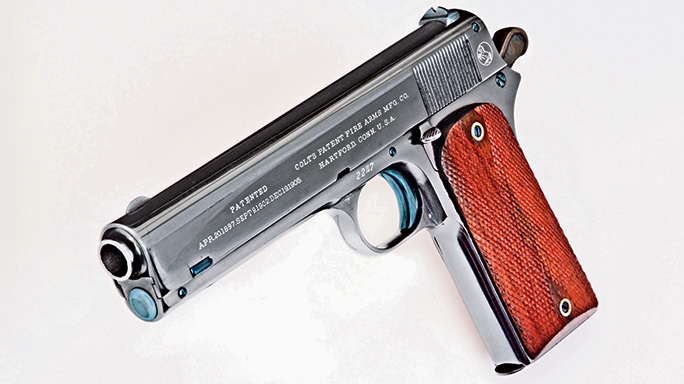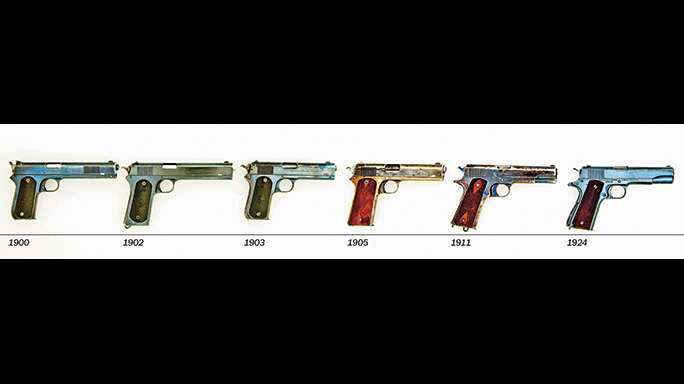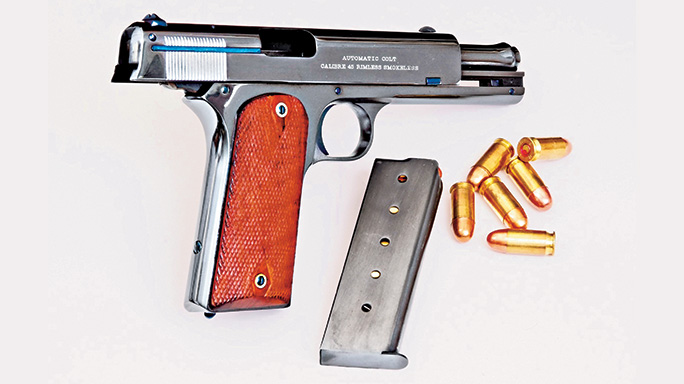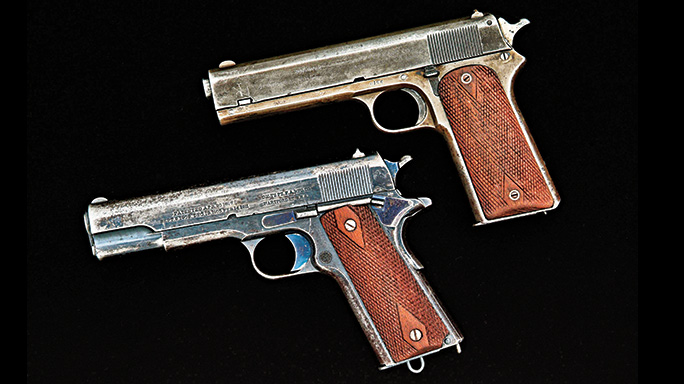Before the turn of the last century, European gunmakers were working in earnest to design a practical self-loading pistol. The first real breakthrough came in 1893 with a design by Hugo Borchardt and his colleague Georg Luger. The Borchardt Automatic Repeating Pistol was an unusual-looking gun, but within its design was the toggle lock action that would become the underpinning for Georg Luger’s first 9mm Parabellum, introduced in 1900.
- RELATED STORY: Gun Review: Rossi R92 .45 Colt Rifle
Though an important and enduring design, the Luger toggle lock was complicated. German armsmaker Mauser came up with an entirely different approach in 1895 by using a bolt mechanism to extract and eject the spent cartridge casing, with the slide re-cocking the hammer on the recoil stroke and the bolt stripping a fresh cartridge from the magazine and chambering it as the slide rebounded. If that sounds vaguely familiar, it is the way almost every semi-auto pistol in the world works. The Mauser design was called the C96, better known today as the Broomhandle Mauser, and it was one of the most influential handguns in history. By 1900 a handful of American lawmen were already carrying Mauser self-loaders. The U.S. government even tested the Luger 9mm and Mauser 7.63mm semi-autos for possible adoption as a new military sidearm. But John Moses Browning, America’s preeminent arms designer, had another idea.
Browning’s earliest patent for a semi-auto is dated April 20, 1897, a date that would appear on the slides of Colt pistols for nearly half a century. Between 1900 and 1911, his designs would make the Colt’s Patent Fire-Arms Manufacturing Co. one of the world’s leading producers of semi-automatic pistols. The road leading up to the introduction of the most famous semi-auto in Colt’s history, the Model 1911, was one previously traveled by a variety of innovative and popular Browning designs for Colt and Fabrique Nationale (FN) in Belgium.
Advertisement — Continue Reading Below
Browning had been responsible for one of the earliest small-caliber autoloaders to find favor with Western lawmen, the Belgian-manufactured FN Model 1900 chambered in 7.65mm (.32 ACP). Browning had licensed his 1897 patent design to Colt’s for that maker’s Model 1900, which was chambered in the new .38 rimless, smokeless caliber (originally called a Colt Automatic Pistol Hammerless cartridge, or CAPH, and later shortened to ACP), a cartridge more closely related to the .38 Long Colt then in use by the U.S. military for the Colt’s double-action (DA) revolver. The Model 1900 formed the basis for an entire series of semi-automatic pistols that would follow for the next century. Though only produced through 1903 and limited to around 3,500 guns, in the design of the Model 1900 can be seen in the foundation for the Model 1905, which preceded Browning’s benchmark Colt Model 1911.
The Military Imperative
One of the great incentives for further development by Browning and Colt in the early 1900s was the U.S. military’s keen interest in seven-shot semi-autos. Both the Army and Navy procured Model 1900 Colt pistols for evaluation, around 50 for the Navy and 200 for the Army. The improved Colt Model 1902 (sporting) automatic pistol found even more favor with the government. Changes in the design were a rounded hammer, a shorter firing pin (deemed necessary to avoid accidental discharge if the hammer were inadvertently struck while a cartridge was chambered), a notched rear dovetail-mounted sight and checkered hard-rubber grips. To meet Ordnance Department requirements, the military versions had a longer grip squared at the butt (as opposed to the rounded-contour grip on civilian models), a lanyard swivel on the lower left side of the grip frame, a slide stop on the left side of the frame and a seven-shot magazine, one more round than civilian versions. The 1902 Military remained in the Colt’s catalog until 1928 with production reaching over 47,000.
Advertisement — Continue Reading Below
In between production of the Model 1902, the Model 1903 and development of the first Hammerless semi-automatic Colt pistols came a design that is regarded as the quintessential stepping stone to the 1911. It was the first .45 ACP semi-auto built by Colt. The new large-caliber handgun was cataloged as the “Model 1905 .45 Automatic Pistol.”
The similarities between the Model 1905 and later Model 1911 are unmistakable, as are the differences. Colt’s first .45-caliber semi-auto used a rimless, smokeless cartridge also designed by John M. Browning. The new gun and .45 cartridge were exactly what the U.S. military had been waiting for—an autoloader with comparable power to the venerable Colt Single Action Army, which had remained the nation’s principal military sidearm until 1892. The big .45-caliber Colt had unwisely been supplemented since then by a series of less effective .38-caliber DA revolvers chambered in .38 Long Colt, .38 S&W and .38 Special, nothing with the punch of an old Peacemaker, that is until the .45-caliber Colt New “Service” DA pistol came along in the year 1909.
It is worthy of note, however, that the U.S. did purchase and issue small numbers of the Colt Model 1878 DA revolver chambered in .45 Colt. In 1905, however, the idea of a .45-caliber semi-auto had greater appeal to the U.S. military. Unfortunately, as a sidearm for servicemen, many of whom had little or no experience with firearms nor held any great interest in learning to become proficient with them, the Model 1905 left a lot to be desired. It was complicated compared to a revolver, and recoil with the semi-auto was substantial. Nevertheless, in 1907 the U.S. government placed an order for 200 Colt .45-caliber semi-autos for evaluation. The military versions required Colt to develop a grip safety, which was engineered by Colt factory designers Carl Ehbets and George Tansley, who patented the design. Browning had also patented a similar grip safety device first seen on the Fabrique Nationale Model 1905-FN 6.35mm pocket models and later on Colt’s Model 1908 Hammerless .25 ACP.
Advertisement — Continue Reading Below
The .45-caliber 1907 contract models (which differed from civilian models built in 1907) also had to be designed to accept a detachable shoulder stock (which Colt later offered as a shoulder stock holster for the civilian market), be configured to use a spur-type hammer, rather than the civilian-style rounded hammer (there were four different hammer designs throughout the gun’s production history), and have a lanyard loop so soldiers could tether the handgun to a braided lanyard worn over the shoulder. In addition, the government wanted modifications to the ejector and ejection port, which was enlarged. All 200 guns, which had their own serial-number range, were equipped with a grip safety and are regarded as the rarest variation today.
Cavalry field tests still found numerous faults with the guns for military application. Reporting on the field tests, Lieutenant Burnett, of Troop H, 4th Cavalry, Fort Snelling, Minnesota, wrote that “…the automatic pistol in its present state, [is] totally unfit for use by troops…I am somewhat doubtful of the wisdom of arming the average enlisted man with an automatic pistol.” Burnett had also commented that the pistols were awkward to handle on horseback and that there was concern over the possibility of an accidental discharge that might result from carrying the pistol cocked and ready to fire. One could question the logic of carrying the Model 1905 cocked, as no soldier or cowboy would have ever carried a Colt SAA cocked in the holster! The Model 1911 would finally assuage this issue with the manual thumb safety, allowing the .45 autopistol to be carried “cocked and locked.”
Although the government tests in 1907 were somewhat damning, Colt and Browning reworked the design once more for the military in 1909, and again in 1910. Among the notable improvements was a change from the double-link barrel locking system to a single toggle link. The Model 1905’s operation was similar to the Model 1902 Military Model (chambered in .38-caliber rimless smokeless) and had the barrel pinned to the frame via two pivoting barrel lugs, thus it was attached at both the muzzle and breech ends, which made the 1905 an inherently accurate handgun. The slide was secured to the frame by a wedge passing through it just below the muzzle; over time this would prove to be a design weakness and one of two principal points of failure with the Model 1905.
Advertisement — Continue Reading Below
Upon firing, the 1905 barrel would pivot back (down), disengaging from corresponding grooves in the slide, allowing it to unlock from the barrel and continue its reward movement. In order to take the 1905 barrel out of the frame for field stripping two small pins had to be punched out; this was a much more complicated method and the second point of failure with pins occasionally fracturing. For the 1911, Browning used a single toggle link that also served to anchor the barrel, thus making disassembly much easier and the overall design much stronger. This also established the tilting barrel design that has remained a global standard among armsmakers for over a century.
Another notable difference in design is that the 1905’s slide is withdrawn from the frame by pulling it off the back, whereas the 1911 slide is removed by puling it forward. Both models also used a recoil spring plug although the designs and operation greatly differed between them. For the 1910 military trials, Browning and Colt made additional changes to the 1905’s grip design and angle, which Browning stated would further improve handling. After an initial field test in February of that year, Colt made a few more modifications, at which point the 1910 looked essentially like the 1911, with the exception of a thumb-activated safety. A second series of tests were conducted in November and the military’s Board of Officers rendered a more favorable opinion but presented yet another list of critiques that Colt would have to address. These would lead Browning and Colt to the final design of the Model 1911.
On March 3, 1911, the latest Colt semi-auto design performed flawlessly, firing 6,000 rounds of ammunition and addressing all of the Ordnance Department’s concerns, including the addition of an external safety so the gun could be carried with the hammer cocked. On March 29, U.S. Secretary of War Jacob M. Dickinson approved the selection of the Colt Browning as the “U.S. Pistol, Automatic, Calibre .45, Model 1911.” The government’s initial order was for 31,344 pistols. After two world wars, over 2,550,000 Model 1911/1911A1s had been produced for the U.S. government.
Advertisement — Continue Reading Below
The final design that emerged for the Model 1911 incorporated all of the features requested by the Ordnance Department and Board of Officers with the exceptions of a loaded chamber indicator and an indicator showing the number of cartridges remaining in the magazine. Neither feature was ever added to the gun’s design, although 1905 and 1911 magazines do have witness holes.
Despite the government’s reluctance and the 1907 contract pistol’s various failures under military testing conditions, Colt’s commercial sales of the Model 1905 reached a total of 6,100 by the time the gun was discontinued in the year 1911.
Old But Not Outdated
Advertisement — Continue Reading Below
Although the Model 1905 had been replaced by the Model 1911, many 1905s ended up in the holsters of lawmen patrolling what remained of the western frontier along the border with Mexico. Things were still pretty unsettled out west in the early 1900s; Arizona and New Mexico wouldn’t even be granted statehood until 1912. Some of the earliest lawmen to adopt .45 autopistols were Texas Rangers. As early as 1912 there are photos of Rangers armed with Colt Model 1911s, and by the postwar era it was to become the most commonly carried sidearm. Among famous Texas Rangers who carried 1911s in the early to mid-1900s were Captain Manuel T. “Lone Wolf” Gonzaullas, who had a specially modified 1911 with a cutaway trigger-guard (like a FitzGerald special Colt revolver), and H. Joaquin Jackson.
- RELATED STORY: Colt Unveils LE6920MPS with Magpul MOE SL Furniture
While the 1905’s successor was adopted as the official sidearm of the U.S. Army, Navy, Marine Corps and numerous federal agencies, the 1911 was not readily available on the commercial market since almost all early production was allocated to the U.S. military, thus John Browning’s innovative Model 1905 would continue well into the early 20th century to pave the way for the future of .45 semi-automatic pistols. Today, a pristine Model 1905 can demand upwards of $7,200 at auction, and they continue to remain a rare and desirable find.
For more information, please visit Colt.com.
Advertisement — Continue Reading Below



























